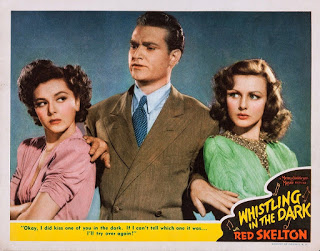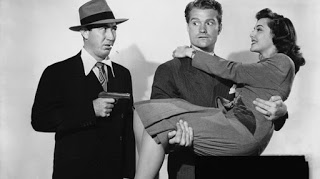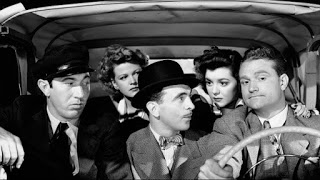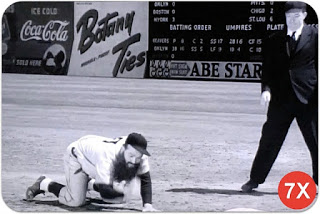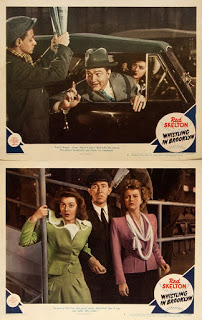The Whistling Trilogy -
with Red Skelton
Whistling in the Dark (1941) – 7/10
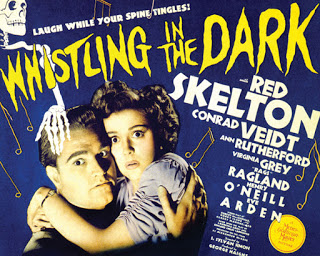
Like a lot of people my age, I grew up on Red Skelton on television. He had
an enormously popular TV skit comedy show The Red Skelton Hour that ran from
1951 to 1971 in which he created a number of memorable characters. My grandfather
who didn't laugh at much of anything would never miss Skelton's show and
would laugh uproariously. As so many comedians did in the 1920's through
the 40's, he started off in vaudeville as a young teenager and from there
moved into radio and finally film. This was his first starring role and he
is excellent in it.
The film was based on a play in which Edward Arnold and Claire Trevor starred
in and then in 1933 it was brought to the screen and Arnold again played
the villain. They made a few script changes and made it a vehicle for the
talents of Skelton. The film is by no means hilarious - Skelton had to follow
the script - but it is fairly enjoyable in that 1940's comedy way - sort
of like a Bob Hope film of the same period.
He plays a radio entertainer called The Fox whose shtick is to solve ingenious
murders. His plots are so clever that a scam Cult Leader (Conrad Veidt) kidnaps
him to plan a murder that he needs doing. To ensure his co-operation he also
kidnaps two women who are infatuated with The Fox. They were played by Ann
Rutherford who was usually Andy Hardy's girlfriend and the lovely Virginia
Grey. Throw in Eve Arden as well and a bunch of other character actors.
The film was popular enough that MGM made two more sequels.
Whistling in Dixie (1942) – 7.5/10
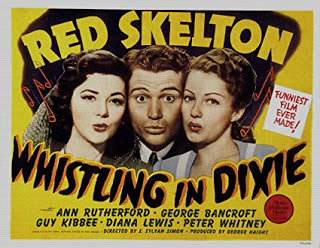
A year after Whistling in the Dark, MGM came out with this sequel which is
actually a better film - better quips, some downright funny slapstick and
a better Skelton who looks like he has found the groove for this character.
A few anachronistic bits of humor in there such as seeing a beetle, Skelton
says "Oh, a Japanese beetle"; "How can you tell?"; "That's easy. The belly
is yellow". This was 1942. Another time Skelton freaks out about the cost
of a long distance cost all the way to Georgia. He gives a guy a tip saying
here is a US Dollar. The guy says, it's only a nickel. "That's after taxes".
Somethings don't change.
So Skelton is back as The Fox who has a radio show in which he solves crimes.
With him is still his girlfriend from the last film Ann Rutherford as well
as a character from the first film who was a comical bad guy with ping pong
balls for brains. He is played by Rags Ragland, one of those character actors
who filled the screens in the studio days - typecast certainly but you have
to love the character. An ex-boxer and performer in burlesque. Here we get
two of them - twin brothers and the film has a few great bits around mistaken
identities. He died in 1946 at the age of 41 and Sinatra sang at his funeral
and Phil Silvers gave the eulogy.
In this one an old friend of The Fox's girlfriend asks for help in solving
the case of a dead man who disappears. Down in the Heart of Dixie. Georgia
to be precise. Comedy ensues.
Whistling in Brooklyn (1943) – 7/10

This final film in the three film Whistling series is pretty good, but I
never did figure out where the whistling comes into play other than a parrot
in the Dixie episode. Still this series is not to be confused with The Whistler
series of films that were an anthology of crime films introduced by the Whistler.
All three films are primarily goofy comedy with a little suspense and crime
thrown in. Red Skelton is clearly on his way to stardom with these films
though it was TV that suited his talents best.
In this one his character The Fox is thought by the police to be a serial
killer and the chase is on with them and the real killers after him, his
girlfriend (again Ann Rutherford), his Man Friday (Rags Ragland - also in
the previous two films) and a newspaper reporter (Jean Rogers from a couple
of the Flash Gordon serials). Lots of quips, hijinks, pratfalls and tumbles
follow in an enjoyable manner.
Best for me was probably some of the outdoor location shooting which was
in the Prospect Park area of Brooklyn, right up the street from my apartment
and in Ebbets Field - though I could not swear it was really Ebbets once
on the field. The Brooklyn Dodgers are also there though mainly we get some
dialogue with Leo Durocher who was the manager at the time (before his scandal
with Lorraine Day after which he was fired). Durocher was known as one of
the nastier players in the Majors but he gave my father his autograph which
I still have so he is an ok egg in my book. The whole skit on the playing
field is very funny. Ebbets Field has a special place in the heart of Dodger's
fans before they moved to Los Angeles but it was destroyed in 1960 and the
space turned into apartments. Such a shame.
All three films are directed by S. Sylvan Simon who shows a deft hand with
broad comedy. I don't know much about him but it seems from his filmography
that MGM used him for all sorts of films from drama to comedy to musicals.
He died at 49.
